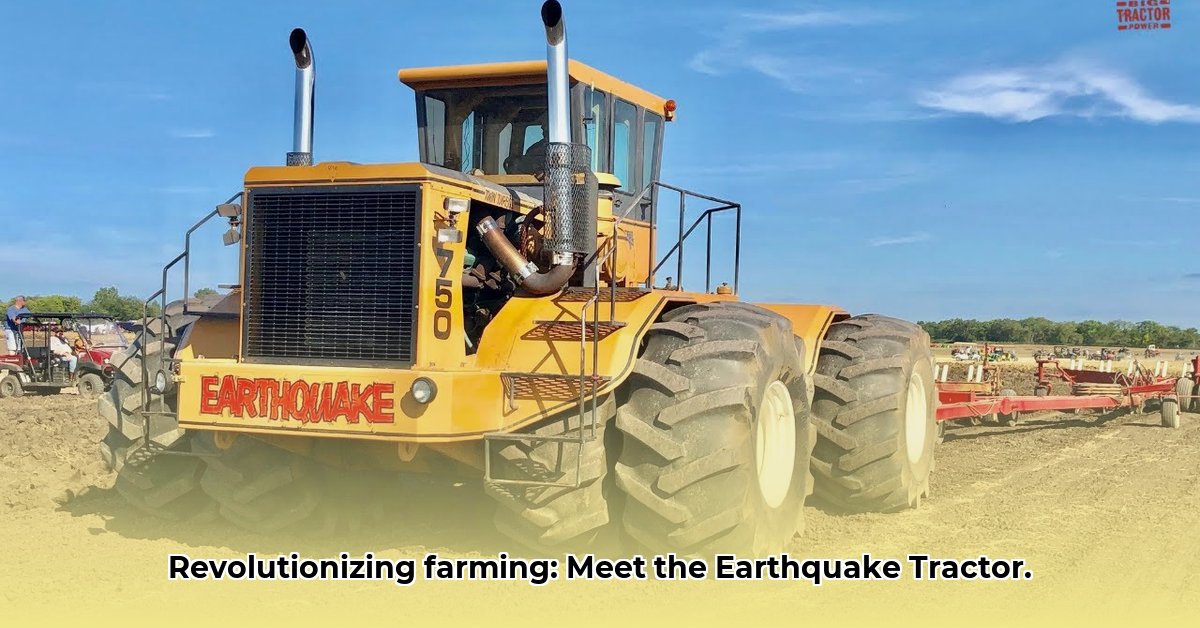
Earthquake Tractor: Rethinking Sustainable Farming's Future
Imagine a tractor so robust it defies the passage of time. Decades after their creation, almost all of these workhorses are still operational. We're talking about the legendary Rite tractors, particularly their powerhouse model, the Earthquake tractor. This isn't just about gears and engines; it's a story about fundamentally altering our understanding of sustainable farming. Could this be the key to a greener future in agriculture? For smaller-scale operations, consider building a chicken tractor.
The Rite Stuff: A Tractor Built to Last
Only 38 Rite tractors ever left the factory floor—a minuscule number considering their profound impact. Manufactured by the D.L. Curtis Company between 1973 and 2019, these weren't your grandfather's farm equipment. Their secret? Simplicity and extraordinary durability. They utilized readily available, high-quality components, making repairs straightforward and reducing dependence on specialized, hard-to-find parts. Think LEGOs versus intricate, custom-designed pieces – easy to fix, easy to replace. This minimized downtime and resulted in a lifespan that renders other tractors essentially disposable.
The Earthquake tractor, the 850-horsepower behemoth of the Rite family, exemplifies this resilience. Its immense power rapidly processed vast fields, a significant advantage for large-scale farming. But how does this translate to sustainable practices?
Efficiency and the Planet: Can We Have Both?
The Rite tractors, including the Earthquake model, weren't merely tough; remarkably, they were also highly efficient. Their ingenious transmission system optimized fuel consumption, significantly reducing their environmental footprint. This is crucial. Modern farming relies heavily on powerful machinery, substantially contributing to greenhouse gas emissions. The Rite tractors challenged this status quo with their innovative design. The question remains: How can we leverage this success on a larger scale?
The Challenge of Scaling Up Sustainability
The Rite tractor's success story has a caveat: scaling it up poses a challenge. These machines were expensive—a new Rite 750 cost an estimated $450,000. This high price point limited their adoption to large farms. While the Earthquake tractor's immense power was ideal for extensive fields, the low production volume prevented its sustainable design from gaining widespread adoption. So, how do we democratize this sustainable technology?
A Blueprint for the Future: Lessons from a Legendary Tractor
The Rite tractor, especially the powerful Earthquake model, offers a valuable blueprint. Its modular design, employing readily available components, simplifies maintenance and reduces the need for specialized parts. Manufacturers aiming to create more durable, eco-friendly equipment could learn immensely from this approach. The emphasis should shift from immediate profits to constructing machines built to endure a lifetime.
The Future of Farming: A Collaborative Effort
We require more than just clever designs; we need supportive policies that incentivize the production and use of sustainable equipment. Imagine a world where farm equipment lasts longer and has a dramatically smaller environmental impact. The Rite tractor, and its Earthquake counterpart, demonstrate that this is attainable. The challenge now lies in making this possibility a tangible reality for farmers of all scales.
Three Pivotal Points:
- The Rite Earthquake tractor's robust design, using readily available components, significantly increased its lifespan and reduced maintenance needs, setting a new standard for longevity in agricultural machinery.
- Its surprising fuel efficiency, due to its clever transmission system, challenged the prevailing notion that high-horsepower equates to high environmental impact.
- The tractor's success highlighted the need for policy changes that incentivize development and adoption of sustainable farming technologies.
How to Reduce Environmental Impact of High-Horsepower Agricultural Tractors
High-horsepower tractors are powerful assets for large-scale farming but contribute significantly to environmental concerns. How can we leverage their power while minimizing their impact?
Optimizing Fuel Efficiency and Reducing Emissions
Improving fuel efficiency is paramount. Modern tractors boast advancements like enhanced engine designs and precision GPS guidance. Precision farming, guided by GPS and sensors, drastically reduces fuel consumption by minimizing overlaps and optimizing routes. This is analogous to having a built-in GPS, ensuring complete field coverage without fuel waste. Furthermore, cleaner-burning engines and alternative fuels like biodiesel or hydrogen are crucial steps towards sustainable farming.
Minimizing Soil Compaction and Embracing Precision Farming
Heavy machinery can compact soil, hindering root growth. Innovative tire designs and controlled traffic farming practices mitigate this, keeping the soil airy and absorbent. Precision farming, utilizing technology to optimize resource use, monitors soil conditions, crop health, and weather patterns, allowing for adjusted fertilizer and pesticide application, resulting in cost savings and minimal environmental harm.
Sustainable Tractor Maintenance
Regular maintenance is surprisingly vital for environmental sustainability. Properly maintained machinery operates more fuel-efficiently and generates fewer emissions. Preventative maintenance mirrors preventative healthcare; it proactively addresses potential problems, ensuring smooth and clean operation.
"Investing in sustainable practices isn't just good for the planet; it's economically sound in the long run," states Dr. Anya Sharma, Agricultural Engineering Professor at Stanford University.